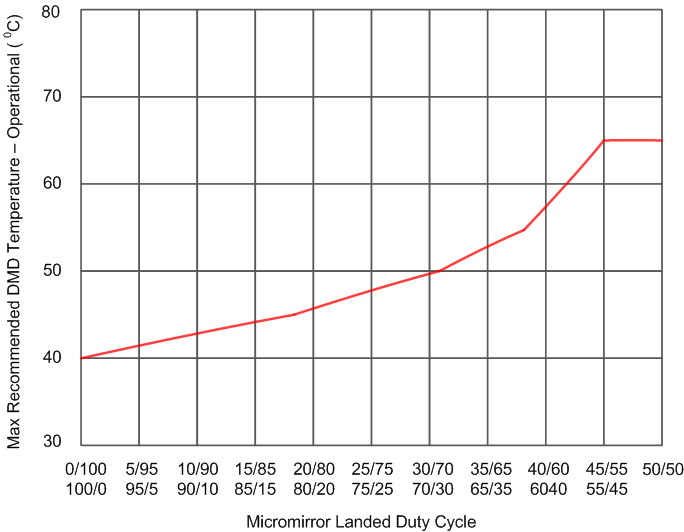DLPS040A October 2014 – October 2016
PRODUCTION DATA.
- 1 Features
- 2 Applications
- 3 Description
- 4 Revision History
- 5 Pin Configuration and Functions
-
6 Specifications
- 6.1 Absolute Maximum Ratings
- 6.2 Storage Conditions
- 6.3 ESD Ratings
- 6.4 Recommended Operating Conditions
- 6.5 Thermal Information
- 6.6 Electrical Characteristics
- 6.7 Timing Requirements
- 6.8 Typical Characteristics
- 6.9 System Mounting Interface Loads
- 6.10 Micromirror Array Physical Characteristics
- 6.11 Micromirror Array Optical Characteristics
- 6.12 Window Characteristics
- 6.13 Chipset Component Usage Specification
- 7 Detailed Description
- 8 Application and Implementation
- 9 Power Supply Requirements
- 10Layout
- 11Device and Documentation Support
- 12Mechanical, Packaging, and Orderable Information
Package Options
Refer to the PDF data sheet for device specific package drawings
Mechanical Data (Package|Pins)
- FLQ|203
Thermal pad, mechanical data (Package|Pins)
Orderable Information
6 Specifications
6.1 Absolute Maximum Ratings
over operating free-air temperature (unless otherwise noted) (1)| SUPPLY VOLTAGES | MIN | MAX | UNIT | |
|---|---|---|---|---|
| VCC | Supply voltage for LVCMOS core logic (2) | –0.5 | 4 | V |
| VCCI | Supply voltage for LVDS receivers (2) | –0.5 | 4 | V |
| VOFFSET | Supply voltage for HVCMOS and micromirror electrode(2) (3) | –0.5 | 9 | V |
| VBIAS | Supply voltage for micromirror electrode (2) | –0.5 | 17 | V |
| VRESET | Supply voltage for micromirror electrode(2) | –11 | 0.5 | V |
| | VCC – VCCI | | Supply voltage delta (absolute value) (4) | 0.3 | V | |
| | VBIAS – VOFFSET | | Supply voltage delta (absolute value)(5) | 8.75 | V | |
| INPUT VOLTAGES | ||||
| Input voltage for all other LVCMOS input pins (2) | –0.5 | VCC + 0.3 | V | |
| Input voltage for all other LVDS input pins(2) | –0.5 | VCCI + 0.3 | V | |
| |VID| | Input differential voltage (absolute value)(2) (6) | 700 | mV | |
| IID | Input differential current (7) | 7 | mA | |
| CLOCKS | ||||
| ƒclock | Clock frequency for LVDS interface, DCLK_A | 440 | MHz | |
| Clock frequency for LVDS interface, DCLK_B | 440 | |||
| ENVIRONMENTAL | ||||
| TARRAY | Array temperature: operational(8)(9) | 0 | 90 | °C |
| Array temperature: non-operational(8)(9) | -40 | 90 | ||
| TWINDOW | Window temperature: operational | 0 | 65 | °C |
| Window temperature: non–operational | -40 | 90 | ||
| | TDELTA| | Absolute termperature delta between the window test point and the ceramic test point TP1 (10) | 10 | °C | |
| RH | Relative Humidity, operating and non–operating | 95 | % | |
6.2 Storage Conditions
applicable before the DMD is installed in the final product| MIN | MAX | UNIT | |||
|---|---|---|---|---|---|
| TDMD | Storage temperature range (non-operating) | –40 | 80 | °C | |
| RH | Relative Humidity (non-condensing) | 95% | |||
6.3 ESD Ratings
| VALUE | UNIT | |||
|---|---|---|---|---|
| V(ESD) | Electrostatic discharge | Human body model (HBM), per ANSI/ESDA/JEDEC JS-001, all pins(1) | ±2000 | V |
6.4 Recommended Operating Conditions
over operating free-air temperature range (unless otherwise noted)| MIN | NOM | MAX | UNIT | ||
|---|---|---|---|---|---|
| SUPPLY VOLTAGES(1)(2) | |||||
| VCC | Supply voltage for LVCMOS core logic | 3.0 | 3.3 | 3.6 | V |
| VCCI | Supply voltage for LVDS receivers | 3.0 | 3.3 | 3.6 | V |
| VOFFSET | Supply voltage for HVCMOS and micromirror electrodes(3) | 8.25 | 8.5 | 8.75 | V |
| VBIAS | Supply voltage for micromirror electrodes | 15.5 | 16 | 16.5 | V |
| VRESET | Mirror electrode voltage | –9.5 | –10 | –10.5 | V |
| | VCCI–VCC | | Supply voltage delta (absolute value) (4) | 0.3 | V | ||
| | VBIAS–VOFFSET | | Supply voltage delta (absolute value) (5) | 8.75 | V | ||
| LVCMOS PINS | |||||
| VIH | High level Input voltage(6) | 1.7 | 2.5 | VCC + 0.3 | V |
| VIL | Low level Input voltage(6) | –0.3 | 0.7 | V | |
| IOH | High level output current at VOH = 2.4 V | –20 | mA | ||
| IOL | Low level output current at VOL = 0.4 V | 15 | mA | ||
| TPWRDNZ | PWRDNZ pulse width(7) | 10 | ns | ||
| SCP INTERFACE(5) | |||||
| ƒclock | SCP clock frequency(8) | 500 | kHz | ||
| tSCP_SKEW | Time between valid SCPDI and rising edge of SCPCLK(9) | –800 | 800 | ns | |
| tSCP_DELAY | Time between valid SCPDO and rising edge of SCPCLK(9) | 700 | ns | ||
| tSCP_BYTE_INTERVAL_ | Time between consecutive bytes | 1 | µs | ||
| tSCP_NEG_ENZ | Time between falling edge of SCPENZ and the first rising edge of SCPCLK | 30 | ns | ||
| tSCP_PW_ENZ | SCPENZ inactive pulse width (high level) | 1 | µs | ||
| tSCP_OUT_EN | Time required for SCP output buffer to recover after SCPENZ (from tri-state) | 1.5 | ns | ||
| ƒclock | SCP circuit clock oscillator frequency(10) | 9.6 | 11.1 | MHz | |
| LVDS INTERFACE | |||||
| ƒclock | Clock frequency DCLK | 400 | MHz | ||
| | VID | | Input differential voltage (absolute value)(11) | 100 | 400 | 600 | mV |
| VCM | Common mode(11) | 1200 | mV | ||
| VLVDS | LVDS voltage(11) | 0 | 2000 | mV | |
| tLVDS_RSTZ | Time required for LVDS receivers to recover from PWRDNZ | 10 | ns | ||
| ZIN | Internal differential termination resistance | 95 | 105 | Ω | |
| ZLINE | Line differential impedance (PWB/trace) | 90 | 100 | 110 | Ω |
| ENVIRONMENTAL(12) | For Illumination Source Between 420 nm and 700 nm | ||||
| TARRAY | Array temperature, Long-term operational(13)(14)(16) | 10 | 40 to 65(15) | °C | |
| Array temperature, Short-term operational(13)(14)(17) | 0 | 10 | °C | ||
| TWINDOW | Window Temperature test points TP2 and TP3, Long-term operational.(16) | 10 | 65 | °C | |
| |TDELTA| | Absolute Temperature delta between the window test points (TP2, TP3) and the ceramic test point TP1 (18) | 10 | °C | ||
| ILLVIS | Illumination, wavelengths between 420 nm and 700 nm | Thermally Limited(19) | mW/cm2 | ||
| RH | Relative Humidity (non-condensing) | 95% | |||
| ENVIRONMENTAL(12) | For Illumination Source Between 400 nm and 420 nm | ||||
| TARRAY | Array temperature, Long-term operational(13)(14)(16) | 20 | 30(15) | °C | |
| Array temperature, Short-term operational(13)(14)(17) | 0 | 20 | °C | ||
| TWINDOW | Window Temperature test points TP2 and TP3, Long-term operational.(16) | 30 | °C | ||
| |TDELTA| | Absolute Temperature delta between the window test points (TP2, TP3) and the ceramic test point TP1 (18) | 10 | °C | ||
| ILLVIS | Illumination, wavelengths between 400 and 420 nm | 10 | W/cm2 | ||
| RH | Relative Humidity (non-condensing) | 95% | |||
| ENVIRONMENTAL(12) | For Illumination Source <400 nm and >700 nm | ||||
| TARRAY | Array temperature, Long-term operational(13)(14)(16) | 10 | 40 to 65(15) | °C | |
| Array temperature, Short-term operational(13)(14)(17) | 0 | 10 | °C | ||
| TWINDOW | Window Temperature test points TP2 and TP3, Long-term operational.(16) | 10 | 65 | °C | |
| |TDELTA| | Absolute Temperature delta between the window test points (TP2, TP3) and the ceramic test point TP1 (18) | 10 | °C | ||
| ILLUV | Illumination, wavelength < 400 nm | 0.68 | mW/cm2 | ||
| ILLIR | Illumination, wavelength > 700 nm | 10 | mW/cm2 | ||
| RH | Relative Humidity (non-condensing) | 95% | |||
Frequency = 60 MHz. Maximum Rise Time = 2.5 ns @ (20% to 80%)
Frequency = 60 MHz. Maximum Fall Time = 2.5 ns @ (80% to 20%)
6.5 Thermal Information
| THERMAL METRIC(1) | DLP6500 | UNIT |
|---|---|---|
| FLQ (CLGA) | ||
| 203 PINS | ||
| Active Area to Case Ceramic Thermal resistance (1) | 0.7 | °C/W |
The total heat load on the DMD is largely driven by the incident light absorbed by the active area; although other contributions include light energy absorbed by the window aperture and electrical power dissipation of the array. Optical systems should be designed to minimize the light energy falling outside the window clear aperture since any additional thermal load in this area can significantly degrade the reliability of the device.
6.6 Electrical Characteristics
over recommended operating free-air temperature range (unless otherwise noted)| PARAMETER | DESCRIPTION | TEST CONDITIONS(1) | MIN | TYP | MAX | UNIT |
|---|---|---|---|---|---|---|
| VOH | High-level output voltage | VCC = 3 V, IOH = –20 mA | 2.4 | V | ||
| VOL | Low level output voltage | VCC = 3.6 V, IOL = 15 mA | 0.4 | V | ||
| IIH | High–level input current(2)(3) | VCC = 3.6 V, VI = VCC | 250 | µA | ||
| IIL | Low level input current | VCC = 3.6 V, VI = 0 | –250 | µA | ||
| IOZ | High–impedance output current | VCC = 3.6 V | 10 | µA | ||
| CURRENT | ||||||
| ICC | Supply current(4) | VCC = 3.6 V | 1076 | mA | ||
| ICCI | Supply current(4) | VCCI = 3.6 V | 518 | |||
| IOFFSET | Supply current(5) | VOFFSET = 8.75 V | 4 | mA | ||
| IBIAS | Supply current(5) | VBIAS = 16.5 V | 14 | |||
| IRESET | Supply current | VRESET = –10.5 V | 11 | mA | ||
| ITOTAL | Supply current | Total Sum | 1623 | |||
| POWER | ||||||
| PCC | Supply power dissipation | VCC = 3.6 V | 3874 | mW | ||
| PCCI | VCCI = 3.6 V | 1865 | ||||
| POFFSET | VOFFSET = 8.75 V | 35 | ||||
| PBIAS | VBIAS = 16.5 V | 231 | ||||
| PRESET | VRESET = –10.5 V | 116 | ||||
| PTOTAL | Supply power dissipation(6) | Total Sum | 6300 | |||
| CAPACITANCE | ||||||
| CI | Input capacitance | ƒ = 1 MHz | 10 | pF | ||
| CO | Output capacitance | ƒ = 1 MHz | 10 | pF | ||
| CM | Reset group capacitance MBRST(14:0) | ƒ = 1 MHz; 1920 × 72 micromirrors | 330 | 390 | pF | |
6.7 Timing Requirements
Over Recommended Operating Conditions unless otherwise noted.| DESCRIPTION(1) | MIN | TYP | MAX | UNIT | |||
|---|---|---|---|---|---|---|---|
| SCP INTERFACE(2) | |||||||
| tr | Rise time | 20% to 80% | 200 | ns | |||
| tƒ | Fall time | 80% to 20% | 200 | ns | |||
| LVDS INTERFACE(2) | |||||||
| tr | Rise time | 20% to 80% | 100 | 400 | ps | ||
| tƒ | Fall time | 80% to 20% | 100 | 400 | ps | ||
| LVDS CLOCKS(3) | |||||||
| tc | Cycle time | DCLK_A, 50% to 50% | 2.5 | ns | |||
| DCLK_B, 50% to 50% | 2.5 | ||||||
| tw | Pulse duration | DCLK_A, 50% to 50% | 1.19 | 1.25 | ns | ||
| DCLK_B, 50% to 50% | 1.19 | 1.25 | |||||
| LVDS INTERFACE(3) | |||||||
| tsu | Setup time | D_A(15:0) before rising or falling edge of DCLK_A | 0.2 | ns | |||
| D_B(15:0) before rising or falling edge of DCLK_B | 0.2 | ||||||
| tsu | Setup time | SCTRL_A before rising or falling edge of DCLK_A | 0.2 | ns | |||
| SCTRL_B before rising or falling edge of DCLK_B | 0.2 | ||||||
| th | Hold time | D_A(15:0) after rising or falling edge of DCLK_A | 0.5 | ns | |||
| D_B(15:0) after rising or falling edge of DCLK_B | 0.5 | ||||||
| th | Hold time | SCTRL_A after rising or falling edge of DCLK_A | 0.5 | ns | |||
| SCTRL_B after rising or falling edge of DCLK_B | 0.5 | ||||||
| LVDS INTERFACE(4) | |||||||
| tskew | Skew time | Channel B relative to Channel A | Channel A includes the following LVDS pairs: DCLK_AP and DCLK_AN SCTRL_AP and SCTRL_AN D_AP(15:0) and D_AN(15:0) |
–1.25 | 1.25 | ns | |
| Channel B includes the following LVDS pairs: DCLK_BP and DCLK_BN SCTRL_BP and SCTRL_BN D_BP(15:0) and D_BN(15:0) |
|||||||
Timing Diagrams
The data sheet provides timing at the device pin. For output timing analysis, the tester pin electronics and its transmission line effects must be taken into account. Figure 2 shows an equivalent test load circuit for the output under test. The load capacitance value stated is only for characterization and measurement of AC timing signals. This load capacitance value does not indicate the maximum load the device is capable of driving.
Timing reference loads are not intended as a precise representation of any particular system environment or depiction of the actual load presented by a production test. System designers should use IBIS or other simulation tools to correlate the timing reference load to a system environment. Refer to the Application and Implementation section.
 Figure 2. Test Load Circuit
Figure 2. Test Load Circuit
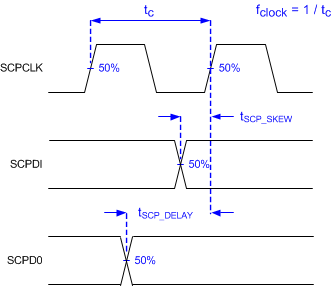
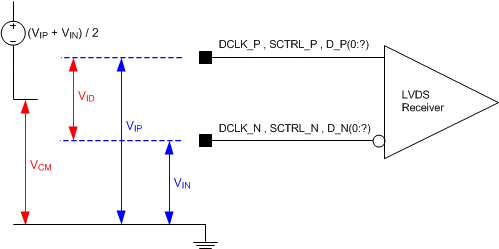
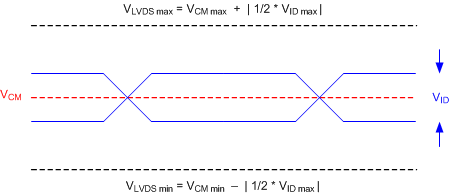
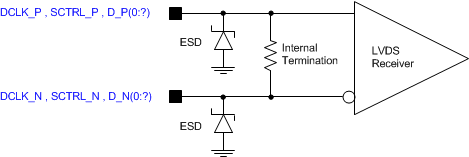

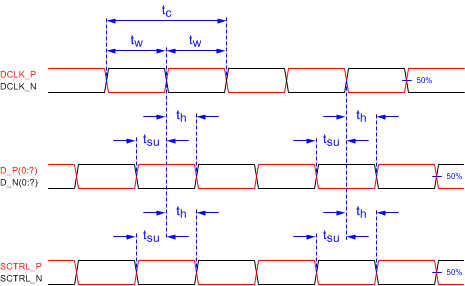
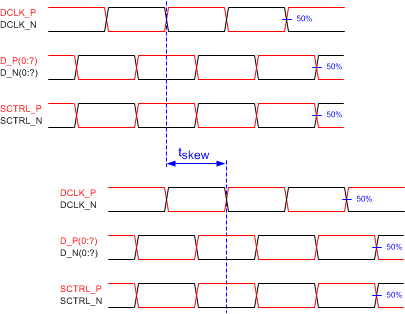
6.8 Typical Characteristics
When the DMD is controlled by the DLPC900, the digital controller has four modes of operation.- Video Mode
- Video Pattern Mode
- Pre-Stored Pattern Mode
- Pattern On-The-Fly Mode
In video mode, the video source is displayed on the DMD at the rate of the incoming video source.
In modes 2, 3, and 4, the pattern rates depend on the bit depth as shown in Table 1.
Table 1. DLPC900 with DLP6500 Pattern Rate versus Bit Depth
| BIT DEPTH | VIDEO PATTERN MODE (Hz) | PRE-STORED or PATTERN ON-THE-FLY MODE (Hz) |
|---|---|---|
| 1 | 2880 | 9523 |
| 2 | 1440 | 3289 |
| 3 | 960 | 2638 |
| 4 | 720 | 1364 |
| 5 | 480 | 823 |
| 6 | 480 | 672 |
| 7 | 360 | 500 |
| 8 | 247 | 247 |
When the DLP6500 DMD is controlled by the DLPC910, the controller operates in pattern mode only. With proper illumination modulation, bit depths greater than 1 can be achieved. Table Table 2 shows the pattern rates for each bit depth.
Table 2. DLPC910 with DLP6500 Pattern Rate versus Bit Depth
| BIT DEPTH | PATTERN RATE (Hz) |
|---|---|
| 1 | 11574 |
| 2 | 5787 |
| 3 | 3858 |
| 4 | 2893 |
| 5 | 2315 |
| 6 | 1929 |
| 7 | 1653 |
| 8 | 1446 |
6.9 System Mounting Interface Loads
| PARAMETER | MIN | NOM | MAX | UNIT | |
|---|---|---|---|---|---|
| Maximum system mounting interface load to be applied to the: | Thermal Interface area (See Figure 10) | 25 | lbs | ||
| Electrical Interface area | 95 | lbs | |||
| Datum “A” Interface area(1) | 90 | lbs | |||
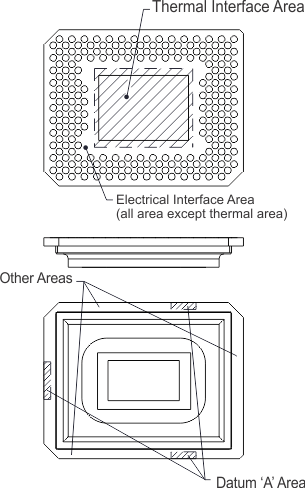 Figure 10. System Mounting Interface Loads
Figure 10. System Mounting Interface Loads
6.10 Micromirror Array Physical Characteristics
| PARAMETER | VALUE | UNIT | |||
|---|---|---|---|---|---|
| M | Number of active columns | See Figure 11 | 1920 | micromirrors | |
| N | Number of active rows | 1080 | micromirrors | ||
| P | Micromirror (pixel) pitch | 7.56 | µm | ||
| Micromirror active array width | M × P | 14.5152 | mm | ||
| Micromirror active array height | N × P | 8.1648 | mm | ||
| Micromirror active border | Pond of micromirror (POM)(1) | 14 | micromirrors /side | ||
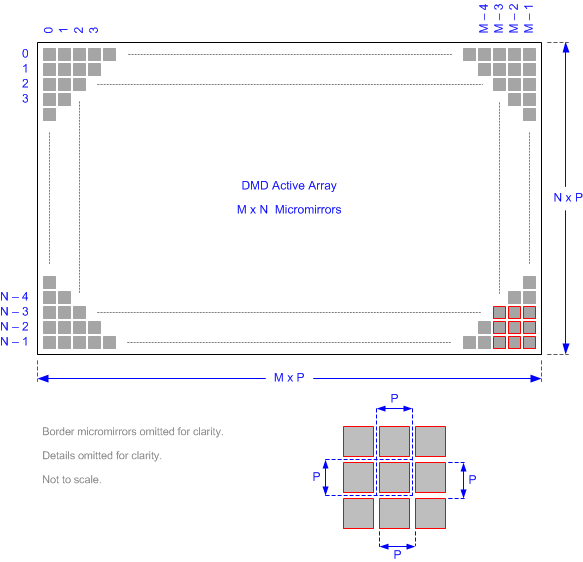
6.11 Micromirror Array Optical Characteristics
See Optical Interface and System Image Quality for important information.
| PARAMETER | CONDITIONS | MIN | NOM | MAX | UNIT | |
|---|---|---|---|---|---|---|
| α | Micromirror tilt angle | DMD landed state (1) | 12 | ° | ||
| β | Micromirror tilt angle tolerance(1) (2)(3)(4)(5) | –1 | 1 | ° | ||
| Micromirror tilt direction(5)(6) (7) | Figure 12 | 44 | 45 | 46 | ° | |
| Number of out-of-specification micromirrors (7) | Adjacent micromirrors | 0 | micromirrors | |||
| Non-adjacent micromirrors | 10 | |||||
| Micromirror crossover time (8)(9) | Typical performance | 2.5 | μs | |||
| DMD efficiency within the wavelength range 400 nm to 420 nm(10) | 68% | |||||
| DMD photopic efficiency within the wavelength range 420 nm to 700 nm(10) | 66% | |||||
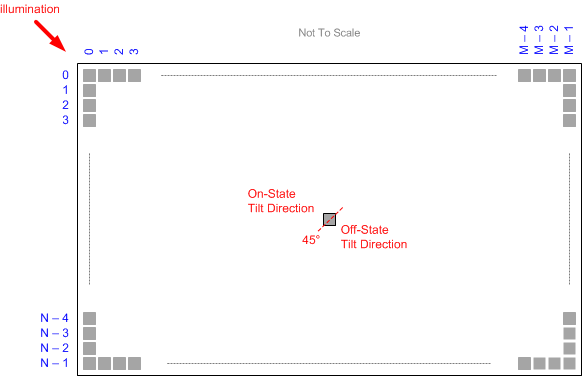
6.12 Window Characteristics
| PARAMETER(1) | CONDITIONS | MIN | TYP | MAX | UNIT |
|---|---|---|---|---|---|
| Window material designation | Corning 7056 | ||||
| Window refractive index | at wavelength 589 nm | 1.487 | |||
| Window aperture(2) | See(2) | ||||
| Illumination overfill(3) | See(3) | ||||
| Window transmittance, single–pass through both surfaces and glass (4) | At wavelength 405 nm. Applies to 0° and 24° AOI only. | 95% | |||
| Minimum within the wavelength range 420 nm to 680 nm. Applies to all angles 0° to 30° AOI. | 97% | ||||
| Average over the wavelength range 420 nm to 680 nm. Applies to all angles 30° to 45° AOI. | 97% |
6.13 Chipset Component Usage Specification
The DLP6500 is a component of one or more DLP chipsets. Reliable function and operation of the DLP6500 requires that it be used in conjunction with the other components of the applicable DLP chipset, including those components that contain or implement TI DMD control technology. TI DMD control technology is the TI technology and devices for operating or controlling a DLP DMD.
